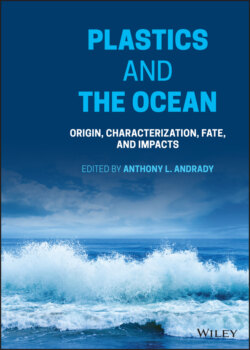Читать книгу Plastics and the Ocean - Группа авторов - Страница 57
2.5.1 Plastic Samples
ОглавлениеThe diversity of detected chemical additives in plastic samples from the marine environment is staggering (Gauquie et al. 2015), but often, the measured concentrations of pollutants are lower than typical loadings expected in plastic consumer goods (Table 2.1). In fact, all additives were lower than 1% by weight of the debris (Figure 2.4). Possible reasons for the lower than expected levels are numerous.
The first reason is that not all polymers are expected to have high loadings of particular additives. Polymer composition of the marine debris samples is fundamental to interpreting the measured additive concentrations, as only some of the diverse polymers require high additive loadings. For example, flexible PVC products often contain high loadings of phthalates, but PVC is a rare polymer in marine debris unless the study focuses on the seafloor (Brignac et al. 2019). PE and polypropylene (PP) that do not contain phthalates are abundant in ocean surface and beach debris (Brignac et al. 2019; Hermabessiere et al. 2017; Figure 2.4). In another example, HBCDs were found at the highest concentrations within plastic debris in expanded polystyrene (EPS) fishing buoy debris (Figure 2.4). But, the HBCD levels were four orders of magnitude lower in PE and PP fragments, indicating that HBCD was intentionally added to the EPS, but not to the PE or PP products.
Figure 2.4 Mean concentrations of additives measured in plastics found in the marine environment, shown in logarithmic units of percent content of the plastic sample. Note: Sample size, polymer type, and reference are shown inside the bars. Data bars are color coded by polymer of samples (light blue = mostly PE and PP; dark blue = only PE and/or PP; yellow = PS only).
Plastic goods tend to contain higher concentrations of additives than in preproduction resin pellets, although pellets also contain some additives (Prunier et al. 2019; Teuten, et al. 2009). Plastic debris originating from fisheries, which is a pervasive and large problem (UNEP 2009), had higher concentrations of Irganox 1076, BHT, 2,4‐DTBP, UV320, and UV327, whereas Irganox 1010 was found at relatively higher levels in food‐contact plastic debris (Rani et al. 2017a). These differences stem from the optimal levels selected by manufacturers driven by the desire to make fishing gear as durable as possible in harsh exposure environments and to meet regulations for food packaging. Some concentrations can be lower than the detection limits; and nondetects should never be ignored and were included as zeros while calculating the average additive concentrations, as shown in Figure 2.4.
A second reason why additives are in lower concentrations than expected is prior leaching from plastic into the environment or degradation of the additive (Rani et al. 2017b; Tanaka et al. 2020). The third reason is some of the additives detected in marine plastic debris could be adsorbed from the surrounding environment rather than being intentionally added. Plastic polymers are routinely used as passive samplers to monitor environmental pollutants in water, because they are excellent at adsorbing compounds from the surrounding environment (Koelmans et al. 2016). Because of this difficulty in determining the source of additives, the use of plastic debris samples to assess global spatial and temporal trends is complicated. Even so, Prunier et al. (2019) noted that mesoplastics from English coastal areas (Massos and Turner 2017; Turner and Solman 2016) or Chinese littoral areas (Wang et al. 2017) had element concentrations in the same order of magnitude as those from the open ocean (Prunier et al. 2019). This differs for organic pollutants, whose concentrations are greater in plastic debris from coastal areas than from the open ocean (Hirai et al. 2011). These findings are likely driven by the global distribution of naturally occurring elements in seawater and point sources influx from human activities in coastal regions (Net et al. 2015).
